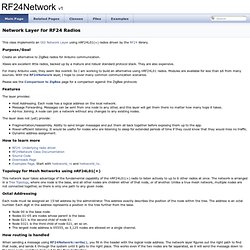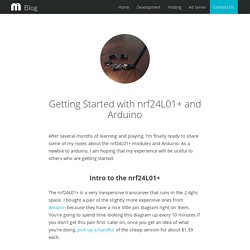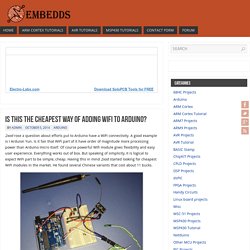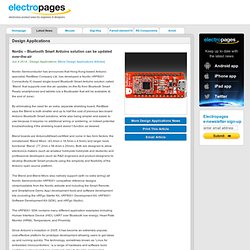

RF24Network: Network Layer for RF24 Radios. This class implements an OSI Network Layer using nRF24L01(+) radios driven by the RF24 library.

Purpose/Goal Create an alternative to ZigBee radios for Arduino communication. Xbees are excellent little radios, backed up by a mature and robust standard protocol stack. They are also expensive. For many Arduino uses, they seem like overkill. Using the ESP8266 module. I obtained my module from an Ebay vendor in the United States.

The shipping was faster than China, but more importantly, the vendor provides the module without the pins soldered in. The 8266 module isn't really breadboard friendly, but it's easy to convert it to a four pin module if you purchase the pin-less version. Tutorial on driving real time clocks with Arduino. Tronixstuff have written a great tutorial how to interface and program real time clocks (RTC).

As an example he took two widely used chips DS1307 and DS3231. The main difference between both modules is clocking mechanism that can result in precision. Usually they come in modules that can be easily connected to microcontroller board via I2C interface. Getting Started with nrf24L01+ and Arduino. After several months of learning and playing, I'm finally ready to share some of my notes about the nrf24L01+ modules and Arduino.

As a newbie to arduino, I am hoping that my experience will be useful to others who are getting started. Intro to the nrf24L01+ Building complete webserver with Arduino, SD card and ENC28J60. Remote Arduino based temperature logger with ESP8266 module. Temperature loggers can be useful and vital in many places.

For instance they can be implemented on greenhouses, freezers and other sensitive environments where temperature changes can cause trouble. Temperature logging can help finding weak spots in the system and help prevent failures in future. Better SPI Bus design in 3 steps. Paul over at Dorkbotpdx has written an article on 3 steps to good SPI Bus design:

Items in store on eBay! RFID123 Arduino Compatible RFID Reader And Decoder Set. Is this the cheapest way of adding WiFi to Arduino? 2xod rose a question about efforts put to Arduino have a WiFi connectivity.

A good example is I Arduion Yun. Is it fair that WiFi part of it have order of magnitude more processing power than Arduino micro itself. Of course powerful Wifi module gives flexibility and easy user experience. Nordic – Bluetooth Smart Arduino solution can be updated over-the-air. Jun 4 2014 - Design Applications [More Design Applications Articles] Nordic Semiconductor has announces that Hong Kong-based Arduino specialist, RedBear Company Ltd, has developed a Nordic nRF8001 Connectivity IC-based single-board Bluetooth Smart Arduino solution called ‘Blend’ that supports over-the-air updates on-the-fly from Bluetooth Smart Ready smartphones and tablets (via a Bootloader that will be available at the end of June).

By eliminating the need for an extra, separate shielding board, RedBear says the Blend is both smaller and up to half the cost of previous two-board Arduino Bluetooth Smart solutions, while also being simpler and easier to use because it requires no additional wiring or soldering, or indeed potential troubleshooting if the shielding board doesn’t function as desired. Arduino controlled 32 channel mains light dimmer. Cheap Alternative for Hard to Find CDS Light Sensor. CdS (Cadmium Sulfide) photo-resistors are commonly used for detecting light levels.

Their resistance varies considerably depending on the intensity of light striking them. They are common, fairly cheap and easy to use. So what’s the problem? They are becoming hard to find. The reason is because of the RoHS directive. If you guessed photo-diode you are close, but even better is the humble LED. Photo-diodes and LEDs Both of these devices are essentially the same. Beam Pattern MB7060-MB7070.gif (1096×838) Beyond the Arduino IDE: AVR USART Serial. A microcontroller is a self-contained, but very limited computer — halfway between a computer and a component.

The top reasons to integrate a microcontroller into your projects are connectivity and interactivity, and one easy way to get your microcontroller talking with the outside world is standard asynchronous serial I/O. Many devices can communicate this way, from wi-fi routers to GPS units to your desktop or laptop computer. Getting comfortable with serial I/O makes debugging your AVR programs much easier because the AVR can finally talk to you, opening up a huge opportunity for awesome.
In this Skill Builder, we’ll set up two-way communication between an AVR microcontroller and your computer. Your computer will command the AVR to blink an LED, then the AVR will open a web page of your choice in a browser at the push of a breadboarded button using serial I/O. Powering Arduino with Batteries thanks to a Battery Shield.
Today we’ll show you how to feed a whole Arduino system from a battery, optimizing energy consumption to ensure that the batteries would provide power to the complete system for few years. Perhaps, the only shortcoming of Arduino is that there aren’t any sophisticated tools in case you want to use a battery power supply. There are software techniques that help limitg the main clock frequency in order to decrease power consumption; however, in our opinion, those methods are not enough to guarantee acceptable battery life. PS2 keyboard codes. [Next] [Art of Assembly][Randall Hyde] Art of Assembly Language: Chapter Twenty Chapter 20 - The PC Keyboard 20.1 - Keyboard Basics 20.2 - The Keyboard Hardware Interface 20.3 - The Keyboard DOS Interface20.4 - The Keyboard BIOS Interface20.5 - The Keyboard Interrupt Service Routine 20.6 - Patching into the INT 9 Interrupt Service Routine 20.7 - Simulating Keystrokes20.7.1 - Stuffing Characters in the Type Ahead Buffer 20.7.2 - Using the 80x86 Trace Flag to Simulate IN AL, 60H Instructions 20.7.3 - Using the 8042 Microcontroller to Simulate Keystrokes.